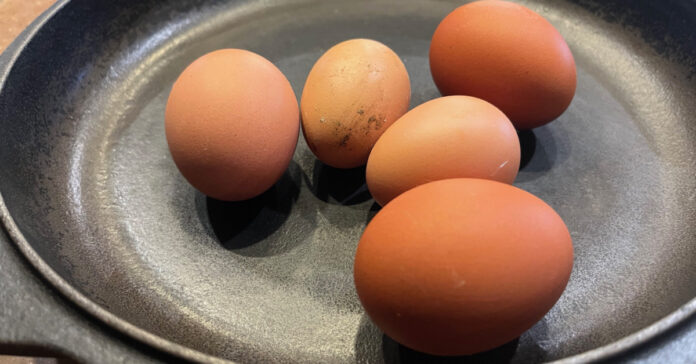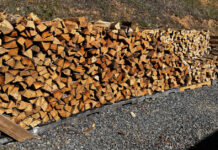
When I fed the chickens yesterday, there was an egg in the middle of the coop, close to the hanging feeder. That’s unusual, because all three laying hens have been laying eggs in their nesting box, like they are supposed to. On the rare occasions when they don’t, they will tuck their egg neatly into the corner. But the center? Hasn’t happened before.
I grabbed the egg and noticed it was small. That caused a mini celebration because it meant the first of our 16 new hens had laid an egg. They are 19 weeks old, and they are supposed to start laying at 20 weeks. One of them jumped the gun.
After replenishing their feed and water, I opened the nesting box, expecting to see my normal three eggs. Instead, there were four, including another small one. So two of the 16 new hens had laid eggs for the first time, and one even did so in the right spot.
For the first time since summer, I harvested five eggs. With any luck, I’ll harvest at least that many tomorrow. And ore than a dozen by January 1. (When they first lay, chickens don’t produce eggs every day. Our older Black Stars do and these Red Stars should within a month or two.)
Egg-onomics
I spend about $45 on chicken feed per month to feed 19 chickens and one rooster. When you add in the small amount of scratch, black oil sunflower seeds, and grit made from oyster shells, my out-of-pocket costs are less than $50 per month. Once the weather warms up and they can do more foraging and our costs will be even lower.
To count our eggs before they are laid, I figure 19 hens will produce at least 16 eggs per day. That will generate at least 480 eggs per month. Assuming we consume 100 per month, we will have 360 eggs, or 30 dozen available for sale. I can sell eggs at $5 a dozen, so that’s $150 in egg sales per month. Maybe more during periods of peak production.
Before we celebrate our $100 in profits, I need to subtract the $81 I paid for the chicks and shipping. Then keep in mind I have been raising these chicks since the first week of August, so I’ve paid for five months of chick feed with no return. I’ll be generating revenue by mid- to late-January, but I won’t pay back my sunk costs and make a switch from a loss to a profit until May.
With any luck, we’ll continue to get a decent amount of eggs through the summer of 2025 when we will repeat the process and raise 20 new chicks. Our profits will drop off next winter because the hens will lay fewer eggs when they molt and then during the dark days of winter.
Egg-cellent for Preppers
I find raising chickens to be well worth it and would continue to do so even if we didn’t sell a single egg. We could supply our needs with four layers, but I’d want least eight to be on the safe side. First, you can always find someone who would be delighted to take a dozen eggs off your hands. Second, they lay less in the winter, so you should have more hens than you need eggs. Third, more chickens means my coop will be warmer, and fourth, you will lose some hens to predation or natural causes.
Some of our chickens are smarter than others, but none of them are brilliant. Chickens do stupid stuff and die or get eaten as a result. You can keep an eye on the birds when they are free ranging to cut down on unexpected deaths, but I don’t think you can entirely prevent them. Your flock will slowly lose members, even if it is a case of them killing their own, so we have learned to start with more hens than you need.
When we have more eggs than we normally consume on hand, my wife looks for recipes and baked goods that take six eggs. We make also quiche or omelets, sometimes having one for dinner. Making a four or five egg omelet is great when you have small eggs from young hens.
You can also scramble up a bunch of eggs and feed them to your dog, back to your chickens, or to other livestock, like pigs. Many people look down on this, but people with excess milk feed it to their pigs or chickens all the time. Why not turn the tables? Eggs are good protein. (Just don’t feed your chickens raw eggs. You don’t want them in the habit.)
Egg-pocalypse-Ready
We decided to raise hens to have a ready supply of self-replicating food for preparedness purposes. And while I realize a disaster could kill our hens, they will live through many potential SHTF scenarios, including a financial collapse. Then our eggs will become a valuable commodity in a barter economy. Or, if we have eight to ten extra people who bug out to our place, we could well eat all 480 eggs ourselves. That will help stretch our food
This is also why we have a rooster. Roosters can be loud and aggressive, but a rooster will make sure our hens produce fertilized eggs so we can find a broody hen to hatch them or we can use our incubator. In a post-SHTF scenario, I want our hens to produce the next wave of egg layers.
I also aim to have six months’ worth of feed on hand, enough to get us through the winter. If I knew we were facing an imminent disaster, I’d buy even more. Chicken feed is near the top of my last-minute prep list.
Maybe chickens should be on your list of preps.







